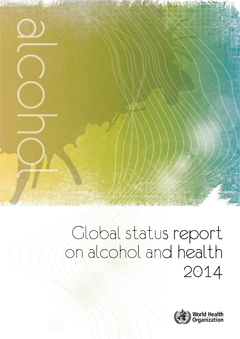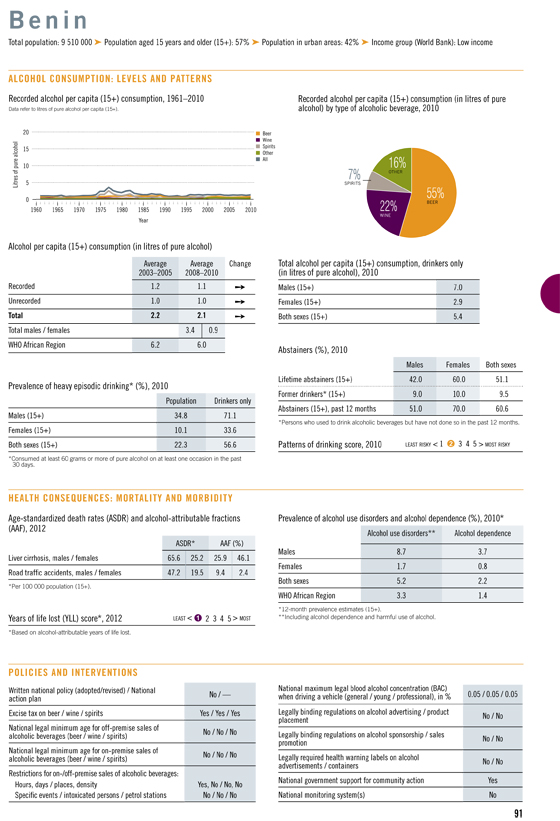WHO: More needs to be done to prevent alcohol-related harm
Worldwide, 3.3 million deaths in 2012 were due to harmful use of alcohol, says a new report launched by WHO in Geneva on the 12th of May. The report confirms that harmful use of alcohol makes people more susceptible to infectious diseases such as tuberculosis and pneumonia.
 A new Global Status Report on Alcohol and Health was published by the World Health Organization in Geneva on the 12th of May. This is the key source to the best data available on the global alcohol situation, covering both consumption figures, estimates of the size and the scope of alcohol-related harm and also information about policy responses in various countries and regions. The report even presents country profiles for alcohol consumption in the 194 WHO Member States, the impact on public health and policy responses.
A new Global Status Report on Alcohol and Health was published by the World Health Organization in Geneva on the 12th of May. This is the key source to the best data available on the global alcohol situation, covering both consumption figures, estimates of the size and the scope of alcohol-related harm and also information about policy responses in various countries and regions. The report even presents country profiles for alcohol consumption in the 194 WHO Member States, the impact on public health and policy responses.
The report and annexes can be downloaded from WHO’s resource site here.
“More needs to be done to protect populations from the negative health consequences of alcohol consumption,” comments Dr Oleg Chestnov, WHO Assistant Director-General for Non-communicable Diseases and Mental Health. “The report clearly shows that there is no room for complacency when it comes to reducing the harmful use of alcohol.”
Strengthened measures to protect public health
Some countries are already strengthening measures to protect people. These include increasing taxes on alcohol, limiting the availability of alcohol by raising the age limit, and regulating the marketing of alcoholic beverages.
According to the new Global Status Report , on average every person in the world aged 15 years or older drinks 6.2 litres of pure alcohol per year. But as less than half the population (38.3%) actually drinks alcohol, this means that those who do drink consume on average 17 litres of pure alcohol annually.
Gender dimensions
The report also points to the fact that a higher percentage of deaths among men than among women are from alcohol-related causes - 7.6% of men’s deaths and 4% of women’s deaths – though there is evidence that women may be more vulnerable to some alcohol-related health conditions compared to men. In addition, the authors note that there is concern over the steady increase in alcohol use among women.
Report highlights
The Gobal Status Report also highlights the need for action by countries including:
- national leadership to develop policies to reduce harmful use of alcohol (66 WHO Member States had written national alcohol policies in 2012);
- national awareness-raising activities (nearly 140 countries reported at least one such activity in the past three years);
- health services to deliver prevention and treatment services, in particular increasing prevention, treatment and care for patients and their families, and supporting initiatives for screening and brief interventions.
In addition the report shows the need for communities to be engaged in reducing harmful use of alcohol.
Lower-income groups more heavily affected
“We found that worldwide about 16% of drinkers engage in heavy episodic drinking - often referred to as ‘binge-drinking’ - which is the most harmful to health,” explains Dr Shekhar Saxena, Director for Mental Health and Substance Abuse at WHO. "Lower-income groups are more affected by the social and health consequences of alcohol. They often lack quality health care and are less protected by functional family or community networks.”
Globally, Europe is the region with the highest consumption of alcohol per capita, with some of its countries having particularly high consumption rates. Trend analysis shows that the consumption level is stable over the last 5 years in the region, as well as in Africa and the Americas, though increases have been reported in the South-East Asia and the Western Pacific regions.
Risk factor for non-communicable diseases
Through a global network, WHO is supporting countries in their development and implementation of policies to reduce the harmful use of alcohol. The need for intensified action was endorsed in the landmark 2011 United Nations General Assembly meeting, which identified alcohol as one of four common risk factors contributing to the non-communicable diseases (NCDs) epidemic, together with tobacco, physical inactivity and unhealthy diets.
Also the 2014 version of the Global Status Report on Alcohol and Health presents country profiles for all member states of WHO, containing key data on alcohol consumption and harm. Here is the country profile of Botswana as an example:

RELATED ARTICLES
- New report highlights benefits of policy measures to prevent harmful alcohol consumption
- Highlighting the COVID-19 – alcohol connection
- Alcohol among risk factors increasing
- WHO consultation on global alcohol strategy and the way forward
- SAAPA applauds WHO position on no industry collaboration
- SAFER – a new WHO initiative to boost national alcohol policy processes
- UN High-Level Meeting on NCDs misses the target
- WHO Launches Global status report on alcohol and health 2018
- Effective alcohol policies are needed now to yield health benefits in the future
- Bolder actions needed to reverse the tide of NCDs and mental disorders

